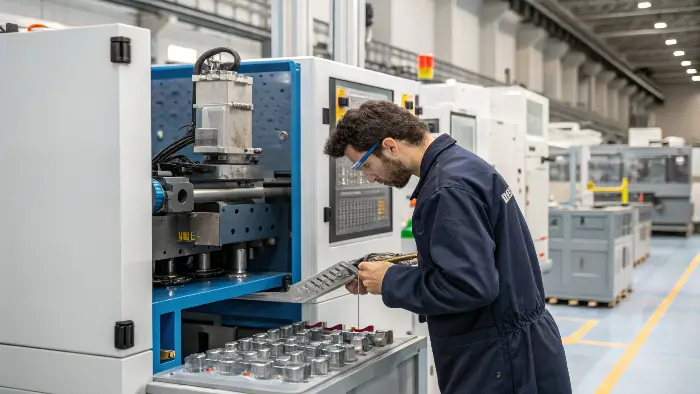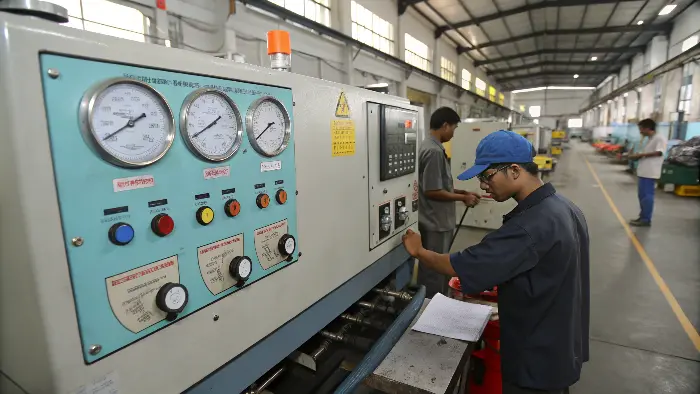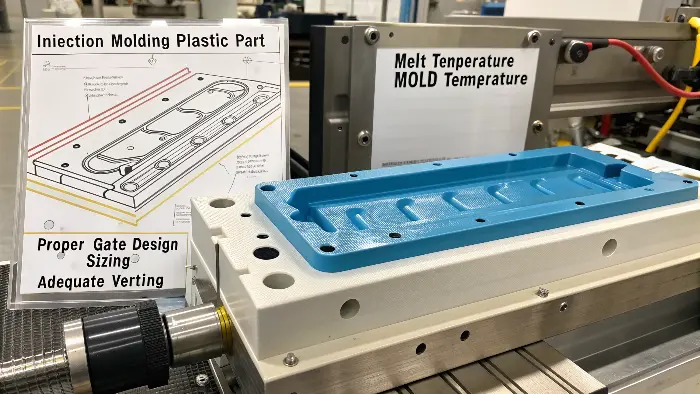Struggling with ugly jetting marks on your molded parts? This common defect compromises aesthetics and strength. Optimizing key process settings is the direct solution.
To eliminate jetting in injection molding, you need to carefully adjust several process parameters. Key changes include optimizing melt temperature, injection speed, and holding pressure, along with ensuring proper mold venting and considering gate design and location.
Jetting is a frustrating issue for many in the molding industry, but understanding its root causes is the first step towards a clean, strong part. I’ve seen it countless times, and a methodical approach always wins. Let’s explore how specific adjustments can make a world of difference. You will want to see how these changes can transform your output.
What Are the Critical Process Parameters for Injection Molding Really?
Feeling overwhelmed by all the machine settings? Producing bad parts costs valuable time and money. Knowing the critical parameters simplifies your troubleshooting and boosts part quality.
The critical process parameters for injection molding fundamentally include melt temperature, mold temperature, injection pressure, injection speed, holding pressure, and cooling time. These settings directly influence the final part’s quality and the overall efficiency of the molding cycle.
When we talk about critical parameters, we mean those settings that have the most significant impact on the final product. I learned early in my career that you can’t just randomly tweak things; you need to understand what each parameter does.
Key Parameters and Their Impact
| Parameter | Usual Impact on Process & Part Quality |
|---|---|
| Melt Temperature | Affects material viscosity. Too low can cause short shots or jetting; too high can lead to material degradation. |
| Mold Temperature | Influences cooling rate, shrinkage, surface finish, and internal stresses. Crucial for dimensional stability. |
| Injection Speed | Determines how fast the mold cavity is filled. Too fast can cause jetting or burning; too slow can result in short shots or flow lines. |
| Injection Pressure | The primary force pushing molten plastic into the mold. Must be sufficient to fill the cavity completely. |
| Holding Pressure | Applied after filling to compensate for material shrinkage as it cools. Affects part weight and dimensions. |
| Cooling Time | The duration the part stays in the mold to solidify. Impacts cycle time and part stability upon ejection. |
These parameters are often interconnected. For example, increasing melt temperature might allow you to reduce injection pressure slightly. I remember a project where we were getting sink marks. We initially focused on holding pressure, but the real culprit was a slightly low melt temperature preventing proper packing. Adjusting that, along with a fine-tune of the holding pressure, solved it. Understanding these core elements is the foundation for mastering molding.
So, How Exactly Do You Reduce Jetting in Injection Molding?
Is jetting still a persistent headache in your production? This defect creates weak points and an unacceptable finish. Specific, targeted adjustments can eliminate this problem effectively.
To reduce jetting, you should primarily focus on increasing the melt temperature or mold temperature, decreasing the injection speed, and potentially increasing holding pressure. Also, critically examine and adjust the gate design, location, and ensure adequate mold venting.

Jetting occurs when the molten plastic is injected into the cavity at too high a velocity through a restrictive gate, causing it to squirt across the mold instead of flowing smoothly along the mold walls. I’ve seen this happen with various materials and part geometries. The key is to promote a more laminar, controlled flow front.
Strategies to Combat Jetting:
- Modify Temperatures:
- Increase Melt Temperature: This lowers the viscosity of the plastic, making it flow more easily and less prone to jetting. Be careful not to exceed the material’s degradation temperature.
- Increase Mold Temperature: A warmer mold surface can help the initial flow front "stick" and spread, rather than jet across.
- Adjust Injection Speed:
- Decrease Injection Speed (especially at the start): This is often the most effective fix. Slowing down the initial entry of plastic allows it to establish a stable flow front that advances uniformly. I often recommend a profiled injection speed, starting slow and then ramping up once the flow is established.
- Optimize Gate Design and Location:
- Gate Position: The gate should ideally direct the flow against an obstruction, like a core pin or an opposite cavity wall, rather than into an open, unrestricted area. This helps to "break up" the jet.
- Gate Type and Size: Sometimes, a fan gate or a tab gate can promote a wider flow front compared to a pinpoint gate, reducing jetting tendency. Enlarging the gate can also reduce the velocity for a given flow rate.
- Ensure Proper Mold Venting:
- While not a direct cause, trapped air can exacerbate flow problems and sometimes mimic or worsen jetting. Good venting ensures air can escape as the plastic enters.
- Holding Pressure Considerations:
- While primarily for packing, ensuring adequate holding pressure after the fill can sometimes help mitigate the effects of minor jetting by better conforming the material. However, it’s not a primary fix for jetting itself.
I recall one specific instance where a client was struggling with severe jetting on a long, thin part. We tried adjusting speed and temperature with minimal success. The breakthrough came when we modified the gate, changing its angle to impinge the flow onto a nearby rib. The jetting disappeared almost immediately. It was a powerful reminder that gate design is absolutely critical.What Are the Overall Parameters for Injection Molding Optimization Then?
Do you want consistently high-quality parts from your molding process? Random adjustments rarely lead to stable results. A systematic approach to optimization is essential for quality and efficiency.
Injection molding optimization involves methodically adjusting key parameters like temperatures (melt and mold), pressures (injection and holding), speeds (injection), and times (cooling, holding) to achieve the desired part quality, minimize cycle time, and reduce waste.

Optimization isn’t just about fixing a single defect like jetting; it’s about making the entire process robust, repeatable, and efficient. I’ve always believed that a well-optimized process is the cornerstone of profitable molding. It’s about finding that "sweet spot" where everything works in harmony.Core Goals of Optimization:
- Consistent Part Quality: This means meeting all dimensional specifications, ensuring mechanical properties, and achieving the desired aesthetic appearance, part after part.
- Minimum Cycle Time: Reducing cycle time directly impacts productivity and cost per part. However, this should not come at the expense of quality.
- Reduced Material Waste: Minimizing scrap, runners (if applicable), and rejected parts.
- Process Stability: Ensuring the process runs consistently over long periods with minimal need for adjustments.
Key Areas and Parameters for Optimization:
Phase Key Parameters to Optimize Filling Injection Speed Profile, Switchover Point (V/P transfer) Packing Holding Pressure Profile, Holding Time Cooling Cooling Time, Mold Temperature Material Melt Temperature, Drying Conditions (if applicable) Machine Nozzle Temperature, Screw Recovery Settings One technique I’ve found incredibly useful for complex optimization tasks is Design of Experiments (DOE). It allows you to systematically test the effects of multiple parameters and their interactions. For example, if you’re trying to minimize warpage while maintaining a fast cycle, a DOE can help identify the optimal settings for mold temperature, holding pressure, and cooling time far more efficiently than one-factor-at-a-time changes. I remember helping a client who was getting inconsistent part weights. A small DOE focusing on holding pressure, holding time, and melt temperature quickly pinpointed the ideal settings and stabilized their process. It’s about a holistic view.
And How Do You Reduce Those Annoying Flow Lines in Injection Molding?
Are you seeing unsightly wavy patterns or distinct lines on your molded parts? Flow lines are a common cosmetic defect. Understanding their cause is the first step to achieving smooth surfaces.
To reduce flow lines, try increasing injection speed, melt temperature, or mold temperature. Also, ensure the gate is designed and sized appropriately, and that the mold has adequate venting to facilitate smooth material flow.

Flow lines, sometimes called "flow marks," often appear as a wavy or ripple-like pattern on the part surface, typically in areas furthest from the gate. They occur when layers of molten plastic cool at different rates as they flow through the mold, or when flow fronts don’t meld together perfectly. I’ve often seen them in thin-walled sections or where the flow path is long.Common Strategies to Eliminate Flow Lines:
- While primarily for packing, ensuring adequate holding pressure after the fill can sometimes help mitigate the effects of minor jetting by better conforming the material. However, it’s not a primary fix for jetting itself.
- Increase Injection Speed: Filling the mold cavity faster can help ensure the material reaches all points before it cools too much, promoting better fusion of flow fronts. This is often a very effective solution.
- Increase Melt Temperature: A hotter melt has lower viscosity and stays fluid longer, allowing it to flow more easily and fill the cavity more uniformly before solidifying.
- Increase Mold Temperature: A warmer mold surface prevents the plastic from cooling too rapidly upon contact, giving it more time to flow smoothly and for different flow fronts to merge properly.
- Optimize Gate Design and Location:
- Gate Size: A larger gate can reduce the shear and allow for a less restricted flow, sometimes helping to prevent flow lines.
- Gate Location: Positioning the gate to ensure a balanced flow path can prevent some areas from cooling prematurely.
- Improve Mold Venting: Trapped air can hinder flow and cause marks that might be mistaken for or contribute to flow lines. Ensure vents are clear and appropriately sized.
- Increase Back Pressure: During screw recovery, higher back pressure can lead to a more homogenous melt, which can sometimes improve flow characteristics.
- Check Nozzle Diameter: A nozzle that is too small can restrict flow and cause issues.
I recall a project involving a large, flat panel where flow lines were a major issue. We incrementally increased the injection speed and raised the mold temperature by just 10°C. These two adjustments together significantly reduced the flow lines to an acceptable level. It’s often a combination of factors, and small, targeted changes can make a big impact.Conclusion
Optimizing key injection parameters like temperature, speed, and pressure is vital to eliminate jetting and other defects, ensuring you produce high-quality, consistent molded parts.
